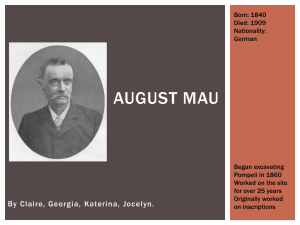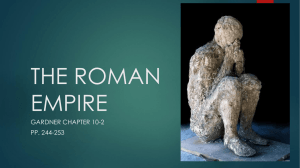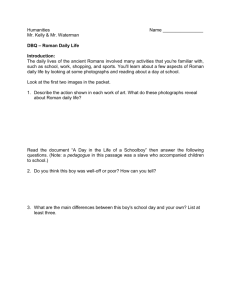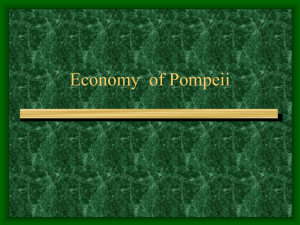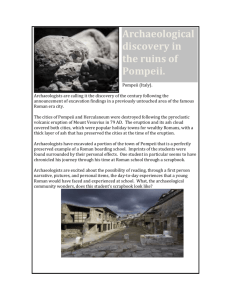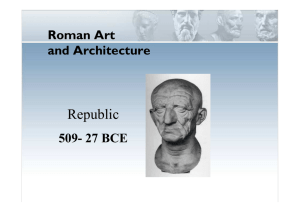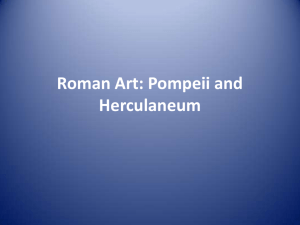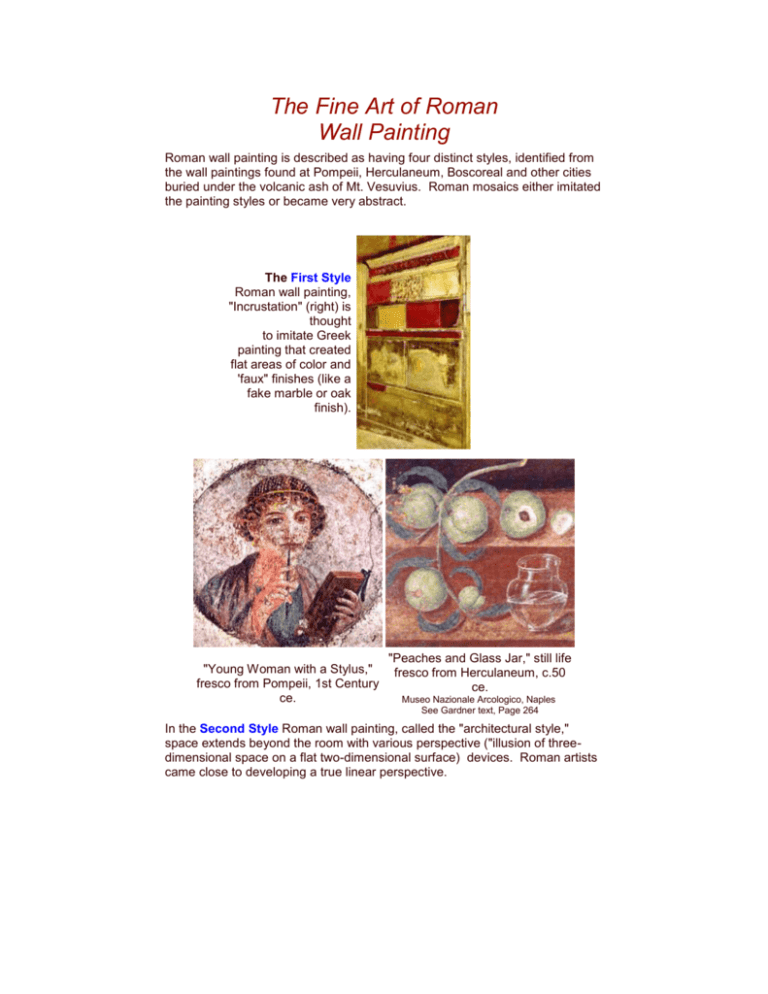
The Fine Art of Roman
Wall Painting
Roman wall painting is described as having four distinct styles, identified from
the wall paintings found at Pompeii, Herculaneum, Boscoreal and other cities
buried under the volcanic ash of Mt. Vesuvius. Roman mosaics either imitated
the painting styles or became very abstract.
The First Style
Roman wall painting,
"Incrustation" (right) is
thought
to imitate Greek
painting that created
flat areas of color and
'faux" finishes (like a
fake marble or oak
finish).
"Young Woman with a Stylus,"
fresco from Pompeii, 1st Century
ce.
"Peaches and Glass Jar," still life
fresco from Herculaneum, c.50
ce.
Museo Nazionale Arcologico, Naples
See Gardner text, Page 264
In the Second Style Roman wall painting, called the "architectural style,"
space extends beyond the room with various perspective ("illusion of threedimensional space on a flat two-dimensional surface) devices. Roman artists
came close to developing a true linear perspective.
Painting from the "Villa of Mysteries," Pompeii, thought
to portray initiation into the mysterious Dionysion cult.
See a different view, Gardner text, Page 259.
Fresco from Boscoreale, in the
"Second Style," to recreate and
extend reality.
Detail from the Villa of
Mysteries, Second
Style Roman Wall
Painting.
Bedroom in the villa of Publius
Fannius Synistor, from Boscoreale
outside Pompeii.
Preserved at the Metropolitan Museum of Art, New
York
Detail from
Boscoreale, c.40
bce, also known
as the "Late
Republican
Style."
The two images
here are from the
"Garden Scene"
below, a fresco in
the Second
Style. To the left,
a heron and
thrush are in an
oleander bush
amid flowering
trees. To the
right, a
nightingale
perches in a rose
bush.
Below, the entire Garden Scene from the House of Livia at Primaporta, c. late
1st Century, bce. Artists used wet and dry plaster (fresco) infused with
powdered marble and alabaster to create a luster. The intent of the artist was
a near photorealism.
In the Third Style Roman Wall Painting, called the "Ornate Style," pictorial
illusion is confined to "framed" images, where even the "framing" is painted
on. The overall appearance is flat rather than a 3-d illusion of space.
Third Style from the Villa at Boscotrecase, near
Pompeii. 1st Century.
Museo Nazionale, Naples
The Fourth Style Roman Wall Painting, called the "Intricate Style," confines
full three-dimensional illusion to the "framed images," which are placed like
pictures in an exhibition. The images themselves do not relate to one another
nor do they present a narrative, as in the Second Style.
The Fourth Style is also characterized by the open vistas and the use of aerial
perspective, as well as the elaborate architectural framing.
Ixion Room from the House of the Vetii,
Pompeii,
1st Century.
Mosaicists used small pieces of colored stone and ceramics as covers for
walls and floors. Ceramic mosaic pieces are called "tesserae."
Detail, Head of a Woman (Venus?) from the
Mosaic "Allegory of Africa," from a
4th Century ce, from a mosaic floor at a
Roman villa at Piazza Armerina, Sicily,
Roman villa in Zippori, Israel.
c.4th Century, ce.
Page Updated
8/28/06
Please use your back button to
return.
Copyright M. Hoover and San Antonio
College,
August, 2001. All rights reserved.
Source: http://www.accd.edu/sac/vat/arthistory/arts1303/Rome4.htm


